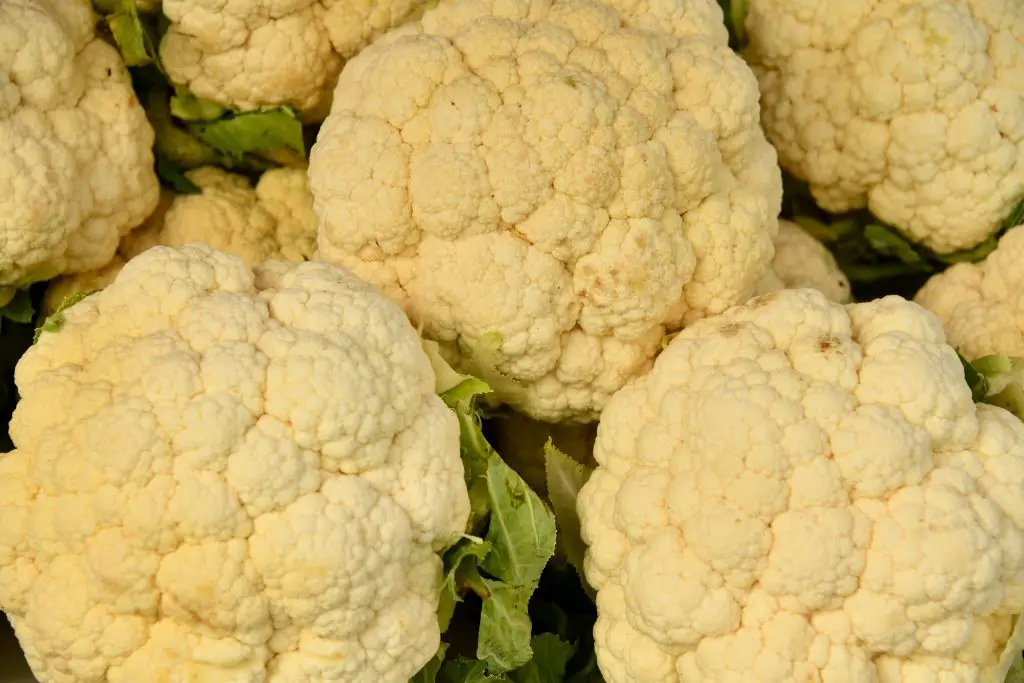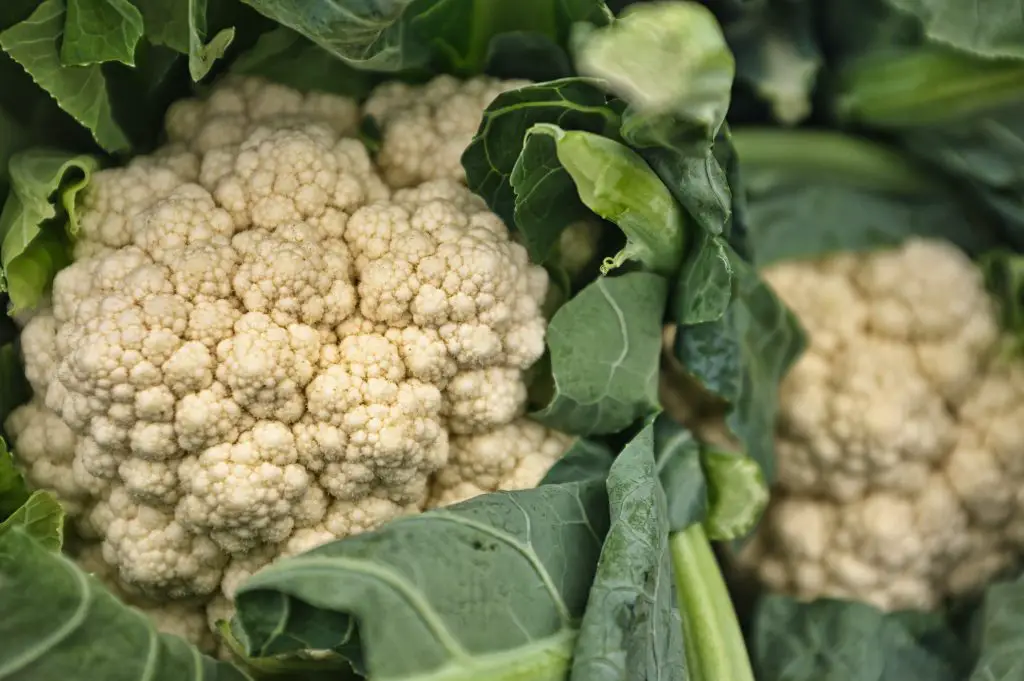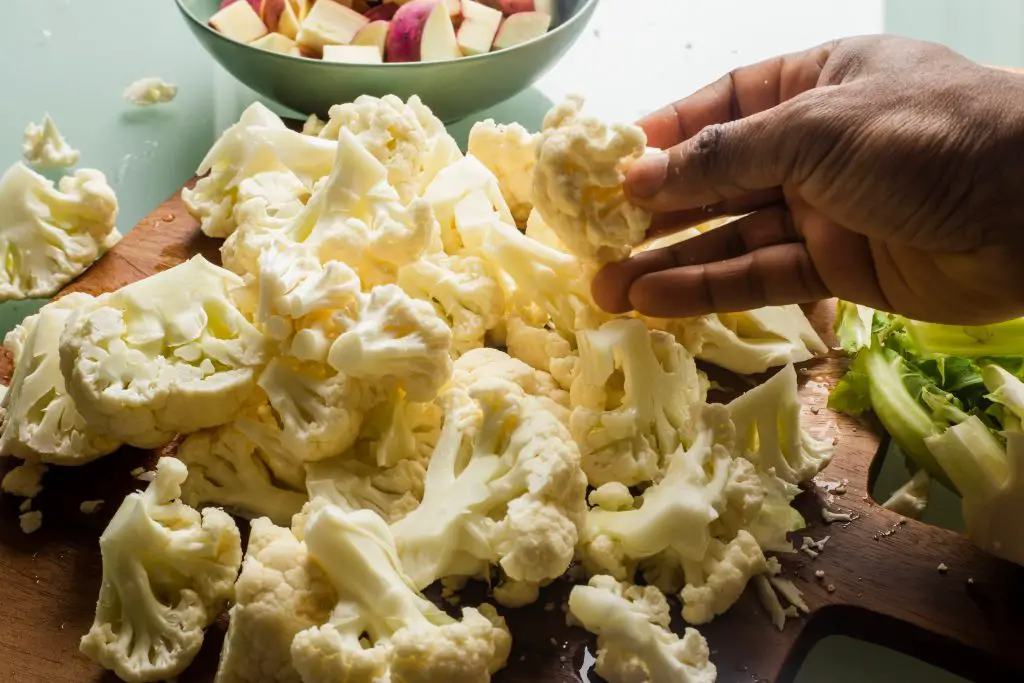How Many Cauliflowers Do You Get From One Plant? Cauliflowers are a really worthwhile vegetable to grow, you can produce beautiful large heads that can be eaten fresh or stored away in the freezer for another time. But how many cauliflower heads can you get from one plant?
Cauliflower plants will produce one head per plant that will typically weigh between 11 and 18 oz (300 and 500gms) and have a diameter of 4 to 7 inches (10 to 18 cm). However, once the Cauliflower has been picked you can induce the cauliflower plant to create secondary heads by removing the leaves of the plant. The secondary heads will be much smaller in size, usually only 3 inches (7 cm) in diameter.
The secondary heads typically appear around 7 to 8 weeks after the primary head is removed. In the right conditions, this can be a useful way to get a second crop. However, Cauliflower is one of the more sensitive crops to heat and light so waiting for a second crop with summer approaching is unlikely to produce high-quality florets. They have a tendency to yellow and go to flower really quickly in warm conditions.
Which Is The Best Time Year To Grow Cauliflower?
It is best to cauliflower in the cooler months of the year which is through Autumn, Spring, and even winter if the winters are mild enough. As the maturity time of Cauliflower is around 4 months it means that Cauliflower seeds need to be started in late Winter to get a crop in late Spring crop or mid to late summer to get an Autumn crop.
However, if you live in a region with mild winters the availability of harvests can be extended into winter by correctly timing the sowing of the cauliflower. To have cauliflower available to harvest the plant needs to be close to maturity at the start of the cold weather. To calculate when to plant it click here.
The other alternative is to plant seeds in early-Autumn. This will result in the plant sitting in the ground until the weather warms up the following spring. This will provide an early spring harvest to increase the availability of fresh cauliflower throughout the year.

How to Grow Cauliflower
The Cauliflower is one of the more challenging plants to grow in the Brassica family which includes Cabbage, Kohlrabi, and Brussel Sprouts, with its nearest relative being Broccoli. This is due to its lack of tolerance of heat which really spoils the quality of the head and causes yellowing of the florets.
To establish Cauliflower seeds can be sown directly into the soil or into seed trays. I personally prefer to use seed trays for a couple of reasons. The first reason is that planting in trays allows you to protection to the seedlings from pests such as snails and slugs.
The second reason is that in winter you can start the seeds off earlier which means that you can get an earlier crop. If you live in a very cold climate you may consider using a heated propagation tray because it is easier to control the temperature. The units are relatively cheap and can be purchased from Amazon, the unit we recommended is the iPower Heated Propagation Tray because it has a vented dome to help control humidity. Click here to see the latest price.

The third reason is that using trays minimizes the amount of time the cauliflower spends in the ground. This allows something else to be grown in the garden while you are waiting. This is particularly beneficial in summer when your beds are overflowing with other crops.
When planting in seedlings trays it is best to use seed raising mix which can be purchased from the local garden center or online through Amazon. 2 to 3 seeds per cell should be planted seeds at a depth of 1 to 2 cm (0.5 to 1 inch) deep. If you need to purchase seeds there are a large number of suppliers that you can purchase from on Amazon or alternatively you can purchase seeds from a specialist supplier like Morgan and Thompson.
When working out the number of seeds to be it is best to plant around double the number of plants you think you will need. This will allow you to select only the best seedlings and also will allow you to replace any seedlings that are destroyed by slugs and snails.
They should be watered regularly when in the trays to ensure that the soil remains moist. It is best done by using a spray gun to ensure they do not get damaged by a heavy downpour for a watering can.
Planting Seedlings In The Garden
It will usually take around 4 to 6 weeks for the cauliflower seedlings to reach a size large enough to be planted out into the garden. When planting them into the garden the seedings should be spaced 40 to 50 cms (16-20 inches) apart when the temperature is at least 7°C (45°F).
In the garden, Cauliflowers prefer a sunny position that gets at least 6-8 hours of sun a day. The soil should ideally be rich, moist, and well-drained. If the soil is lacking in nutrients it is advisable to add plenty of compost and organic matter. I generally prefer to use the no-dig approach to soil preparation as it is quick, easy and generally reduces the volume of work required in the garden. To read more about this method click here.
When the seedlings are first planted out they will be most susceptible to attack from pests such as slugs and snails. As such it is advisable to sprinkle snail pellets around the seedlings which can be purchased online at Amazon. The alternative is to use cloches to provide a physical barrier. These can be made from plastic milk cartons with the bottom cut out.

Caring For Cauliflowers
Cauliflowers generally require very little maintenance once they get going. The main two considerations are ensuring that the soil remains moist by regularly watering. It is also advisable to remove any lower leaves that are yellowing as do not help the plant and provide a potential avenue for pest to get into the plant.
As the head begins to form they need to be covered over to prevent light from reaching the head as this will cause them to yellow. To exclude light the leaves can be tied over the head, the easiest way to do this is to use clothes pegs or alternatively you can use string or rubber bands.
However, to avoid the need to do this, self-blanching varieties can be grown. These blanching varieties naturally produce leaves that cover the heads. To find a list of self-blanching varieties click here.
When to Harvest Cauliflower
Cauliflowers should be harvested as soon as the head reaches a good size. This is because the quality of the head deteriorates becoming grainy and discolored if left too long in the garden. This process happens extremely quickly in warmer weather and is one of the reasons why Cauliflowers do not do well in the heat. If there are any signs of the curds, within the head separating, it should be harvested immediately.
How to Store Cauliflower
If you are planning to store Cauliflower for later it is best to harvest it in peak condition. When storing it short term it is ideally stored in a cool and moist place at a temperature between 0 to 4°C (32° to 40°F) and 90 percent relative humidity. As most refrigerators are cold but not moist the moisture can be increased by wrapping the Cauliflower in a damp cloth or paper towel. In these conditions, the Cauliflower will keep for 2 to 4 weeks.

For longer-term storage Cauliflowers may be frozen, however, blanching is required prior to freezing to stop enzyme activity within the Cauliflower from degrading it when frozen.
This process of blanching, done during the growing process, is different from the one required for freezing. Blanching for storage requires the vegetable to be placed in boiling water for a short period of time, to prevent the loss of flavor, color, and texture when frozen. If you are unfamiliar with how to blanch, the steps are provided below;
- Step 1: Wash the Cauliflower and cut the Cauliflower into smaller pieces.
- Step 2: Submerse the Cauliflower in a large pot of boiling water for 2 minutes.
- Step 3: Stop the cooking process by immediately plunging the Cauliflower into the ice water to cool, for around the same amount of time as the blanching, and then drain thoroughly.
- Step 4: Pack the Cauliflower into containers to freeze. Resealable plastic bags, or tupperware containers are ideal for this purpose. Ensure each bag or container is labelled with dates.
